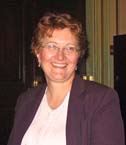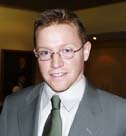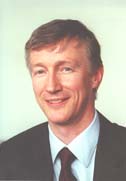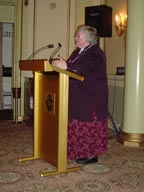
D E P A R T M E N T O
F H E A L T H P O L I C Y,
M A N A G E M E N T A N D E V A L U A T I O N
- N E W S B Y T E S -
Website
November/December 2004
NewsBytes
CONTENTS
Office of the Chair
Research
Education
Honours and Awards
Appointments
Students
Alumni
Other Notables
Back Issues
Alumni |
|||||||||||||||||||||||||||||||||||||||||||||||||||
Highlights of the 2004 Annual General MeetingThis year's Annual General Meeting, sponsored by DINMAR, was about recognizing our alumni…and a little bit of business. Members of our 2003-04 Executive Committee worked tirelessly to ensure high quality events, timely communications and significant improvements to our many deliverables. All members have returned for another term, and we have welcomed two new members as well. The SOG 2004-05 Executive Committee are:
AGM Award WinnersI am pleased to announce that Malcolm Moffat was the recipient of this year's Leadership Award, and Deborah Tregunno was the recipient of this year's Graduate Literary Award. 
Dr. Tregunno received the literary award for her publication entitled "Competing Values of Emergency Department Performance: Balancing Multiple Stakeholder Perspectives." Deborah is a PhD graduate of the class of 2002 and this publication is a direct result of her dissertation on this topic. She also holds a Masters degree from the University of Alberta (1985). Prior to her doctoral studies, Deborah worked in a variety of management positions, most recently as a Program Director at Sunnybrook Hospital . She has a long standing interest in issues of quality improvement, how to best meet departmental objectives, and harmonizing different stakeholder perspectives in assessing performance. Deborah is currently an Assistant Professor at York 's University's School of Health Policy and Management as well as the School of Nursing . The award-winning article, co-authored by Drs. Ross Baker, Jan Barnsley and Michael Murray, was published in Health Services Research 39:4, Part 1 (August 2004). Congratulations Deborah! To read about Malcolm Moffat's leadership contribution to the rehabilitation field of health care, please see his profile below. AGM Key Note Speaker
I would like to try to recount one very powerful analogy that Sister Elizabeth described to us… that of the Inukshuk and how it symbolizes today's leader. Inukshuk are created by Canada's First Nations people by piling various-sized rocks one on top of the other, carefully balancing them so that they miraculously maintain their shapes despite weather and time. The Inukshuk are often formed in the shape of a person and are regarded as works of art by many. But the Inukshuk perform a very valuable service as a form of communication amongst nomadic tribes often separated by great distances. Each Inukshuk tells a story… one may point to a spot where the fishing is good… another may indicate that there is food buried beneath… yet another may indicate that the last group went that way… Although they are nomadic and distant, through the Inukshuk, these tribes have a real sense of community. The magic of the Inukshuk is accentuated by the fact that they can only be made from broken rocks…. Something new is created from the pieces that most would view as broken or useless! Leaders today are challenged to create a sense of community and shared vision within organizations that often span multiple campuses separated by great distance. Leaders today are challenged to make difficult decisions that many view as dismantling the culture, history and integrity of organizations that have existed for decades… Leaders are surrounded by broken "rocks". And yet, the true leader, will use those broken rocks to create a work of art that tells a story to those who will come after. The artist does not always receive direct credit for his/ her work…. but must be contented by the fact that he/ she is an architect of progress. Thank you, Sister Elizabeth, for your honesty, your insightfulness and most of all your inspiration. VIEW Sister Elizabeth's presentation: "Leaders Today: Finding The Good, Holdin' Ground" (PowerPoint). Welcome to New Business Manager - Malak SidkyMalak Sidky has agreed to re-join the Executive Committee as our Business Manager. Malak is a graduate of the HPME class of 1993 and held the Business Manager position from 1991-1996. Malak is also doing some contract work for Novo Nordisk Canada , and Cercle de l'Amitié, a Francophone cultural organization. Malak can be reached at msidky@rogers.com. First Joint Annual CCHSE/HPME Professional Education DayOn January 18, 2005 , the Canadian College of Health Services Executives (CCHSE), GTA Chapter, and the HPME Society of Graduates will host their first joint professional development event: "Does Culture Eat Strategy for Lunch?" The keynote speaker is Brian Lee, President, Custom Learning Systems. Brian brings a wealth of experience in the leadership arena and works with organizations in improving corporate culture in order to be successful in reaching strategic goals. For more information on this event, please see the HPME website: www.utoronto.ca/hpme/alumni/alumni.htm This event will be held from 8:30-12:30 , followed by lunch, at the Park Hyatt Hotel at a cost of $125. To register, please contact Malak Sidky at msidky@rogers.com or call 905-281-5001 ext. 3045. If you are a CCHSE member, please register on the CCHSE web site www.cchse.org. Please note that this is a 3.5 MOC Category 1 event. Matthew Anderson Leads Development of Integrated Community-Hospital Information System
This summer University Health Network (UHN) and the Toronto Community Care Access Centre (CCAC) launched a new initiative to integrate their computer systems, under the leadership of Matthew Anderson (MHSc 1997), Vice President and Chief Information Officer (CIO) at UHN and recently appointed to the joint CIO position at Toronto CCAC. The new partnership initiative will develop an Information Systems operating plan for the Toronto CCAC. Matthew's leadership drives collaboration, consistency, standards, and cooperation to facilitate the electronic sharing of key referral information among community providers and partner hospitals. Matthew describes the benefit of the new integrated UHN/CCAC information system, versus the traditional silo approach: "Once we build this technology bridge to integrate confidential electronic patient records, it will mean healthcare professionals at both organizations will have enhanced access to information which will help streamline patient referrals and allow physicians and clinicians access to important clinical information about patients to enhance their decision-making." Matthew began working at the UHN in 1998 as Administrative Director for Shared Information Management Services. He has implemented a number of electronic tools to enhance the UHN's clinical and administrative functions including computerized physician order entry and results review system, electronic ECG system, and on-line pathology orders, as well as the implementation of an automated discharge summary, and development of intuitive voice recognition tools – initiatives that have had a dramatic impact on reducing the paper record, changing dictation practices, and resulting in a projected cost reduction of 75%. Alumni ProfilesAlumni of the Department of Health Policy, Management and Evaluation (HPME) are involved in a broad range of leadership activities across the health care sector. To promote greater awareness of the many accomplishments and innovations of this diverse group, we are pleased to include alumni profiles as a regular feature of NewsBytes. This issue features Malcolm Moffat, President and CEO of St. John's Rehabilitation Hospital in Toronto, Chair of the Toronto Acquired Brain Injury (ABI) Network and Adjunct Faculty in the Department of HPME. Malcolm Moffat - Recipient of 2004 SOG Leadership Award
“This is a great place” Malcolm Moffat says of St. John's Rehabilitation Hospital and ushers me into his office, where a framed certificate attests to his having received the Society of Graduates' Leadership Achievement Award at our recent Annual General Meeting in October. Had McGill University accepted Malcolm into medical school some twenty-five years ago and satisfied his childhood dream, he might have met me today in a white coat. Instead, he studied cell and molecular and developmental biology and worked in a laboratory for 2 years on chemotherapy research. His managerial talent and an encouraging supervisor led to his having increasing responsibilities there for purchasing, scheduling, budget and this, combined with his innate liking for people, made him seek out the UofT Health Administration program, from which he graduated in 1983. A practicum project as a student on closing the Chedoke emergency department [a project that ultimately took ten years to complete] educated him about the perspectives of communities and health care consumers. From his first job, projecting the aging Baby Boomers' needs for acute care beds, Malcolm has always focused on a systems approach to health care service planning. This was reinforced at the District Health Council and in his role as administrative director of Sunnybrook's surgical program, introducing program management there. His approach is always to consult widely, and involve colleagues across the continuum of care: “you have to talk to a lot of people, get their points of view, get them onside”. He feels his listening and conflict-resolution skills, probably innately above average, were honed during his tenure as a Facilities Planner at Sunnybrook, responsible for allocating space: “it is the toughest job, you can't possibly please everyone”. After 10 years as a vice-president at St. Michael's Hospital, where he helped to introduce program management, and oversaw the renovation or replacement of over 500,000 sqaure feet of space, Malcolm moved to St. John's Rehab, as President and CEO. And his first challenge was not long in coming: three days into his tenure, SARS broke out in nearby Scarborough and St. John's like all GTA hospitals faced serious constraints on most of its activity. Even more difficult was the second phase of SARS [‘SARS II.'], brought to light by St. John's staff who identified a group of their patients with suspicious respiratory symptoms after SARS had already been considered over. A still-new leader, Malcolm had to carry their concerns forward to the Ministry, Public Health, and to colleagues in the health care system; the experience left him, among other things, with the highest regard for the St. John's staff professionalism and their collegial support of one another. Malcolm is especially glad of the opportunity St. John's provides, to focus on the continuity of care and to partner with caregivers across the health care spectrum from community care through acute care and rehabilitation. He has been involved in several key partnering initiatives, for example, one in neuroscience and one in transplantation, which involve extensive partnering with specialized acute care units [at Sunnybrook & Womens, and Baycrest Centre for neurosciences, and the University Health Network for transplantation]. A current GTA-wide partnership to reduce waiting times for total joint replacements finds St. John's again at the table. As well as integrating clinical care, St. John's stresses integration in research and in education; for example, clinicians learning about specialized rehabilitation of burn patients learn at the same time about the care offered in the acute hospital setting (at Sunnybrook and Womens) and the implications of what they do, as the patient re-enters a community care setting. Cross-appointments help facilitate these connections, and staff are encouraged to maintain relationships with colleagues in other sectors, to talk with them – and, even more important, to listen - about their requirements. Malcolm is proud of St. John's involvement in the GTA Rehab and the ABI Networks : “they show what people can do if they come together with a passion to move things forward”. Malcolm is a firm believer in the advantages of program management [instead of a department-based structure] but says that matrix management with a dual reporting relationship [eg., Professional Practice Leaders for allied health workers] can only work well, as long as there are very clear role definitions and division of labour. It takes a lot of work and constant communication to sustain a team approach and shared vision, but the very good results to be achieved are worth it, he believes. As Chief Operating Officer, Toronto Bayview Regional Cancer Centre, he helped pioneer multi-disciplinary clinics, where patients could consult all the relevant professionals in one clinic rather than having separate clinics for chemotherapy, radiation, surgery, etc. This integrated, patient-focussed model, has since been adopted by several cancer care centres across the country. Malcolm is clearly a leader who listens and consults, but who is not content to do that alone. Throughout a long and varied career he patiently and persistently works toward integrating and maximizing continuity of care, enhancing health care services and better meeting patients' needs. |
<<Previous Item |
Table of Contents |
Next Item>> |
 We were very fortunate this year to have a very special guest speaker,
Sister Elizabeth Davis ('85). It is virtually impossible to summarize
Sister Elizabeth's speech in mere words. Simple text cannot duplicate
the emotion and conviction with which Sister Elizabeth delivered
her message. There is no way to do justice to the very personal and
special anecdotes that Sister Elizabeth shared with us, and we feel
so privileged to have heard. Sister Elizabeth made all of us laugh
and many of us cry… but most importantly, she made all of us listen.
We were very fortunate this year to have a very special guest speaker,
Sister Elizabeth Davis ('85). It is virtually impossible to summarize
Sister Elizabeth's speech in mere words. Simple text cannot duplicate
the emotion and conviction with which Sister Elizabeth delivered
her message. There is no way to do justice to the very personal and
special anecdotes that Sister Elizabeth shared with us, and we feel
so privileged to have heard. Sister Elizabeth made all of us laugh
and many of us cry… but most importantly, she made all of us listen.